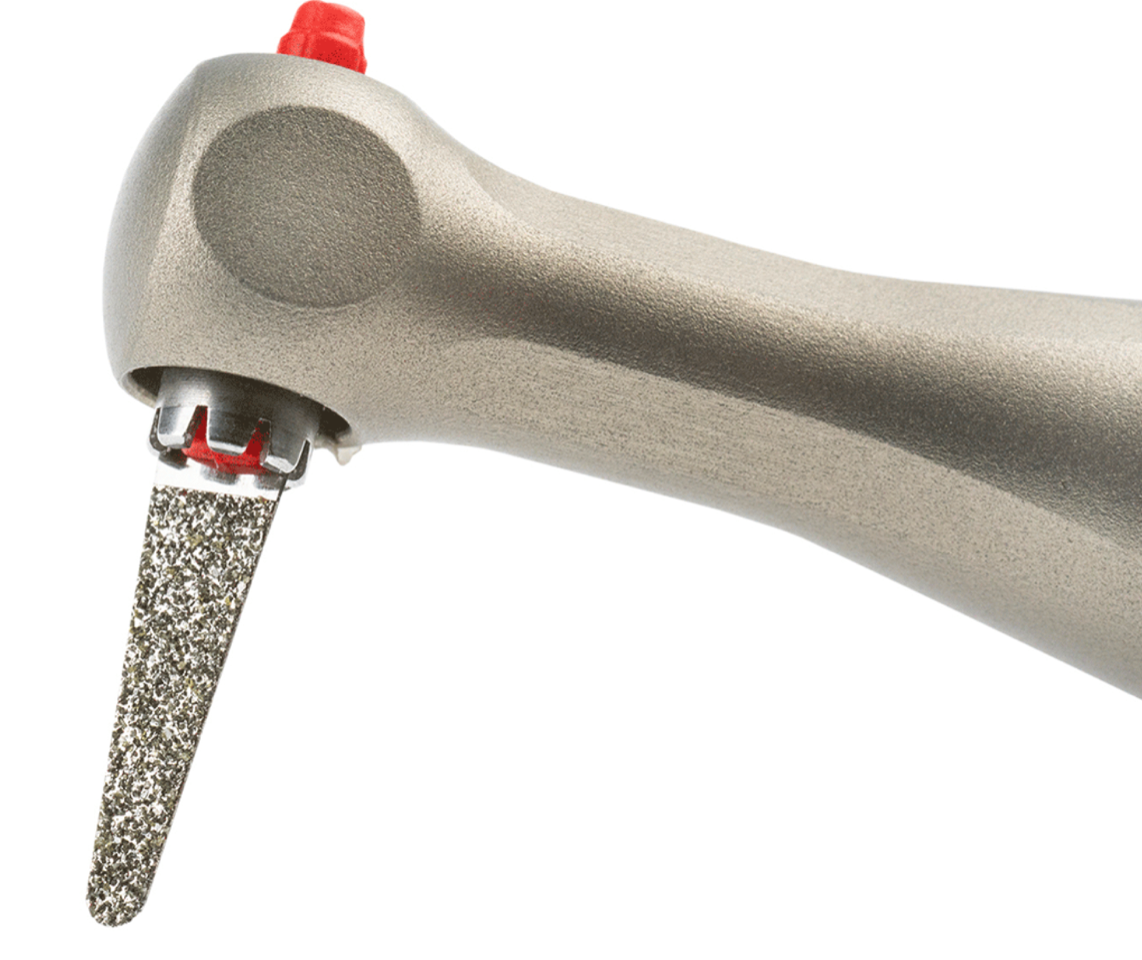Even after practicing dentistry for nearly 20 years, gaining access to the interproximal space—especially below the area of contact between 2 teeth—is tremendously difficult. On a regular basis, I must deal with the following:
- Large and small interproximal composite overhangs
- Retained cement
- Enamel defects
- Composite voids
- Tenacious calculus
Profin® Reciprocating System
The Profin Reciprocating System is designed for the shaping, contouring, and polishing of natural dentition and cosmetic restorations. It is said to remove bulk and interproximal and subgingival residual bonding materials in all parts of the dental arch. The system is comprised of contra-angles and the flat Lamineer® diamond tips.
Dentatus
800-323-3136 | dentatus.com
These very common clinical nuisances are difficult to smooth off because of their lack of clinical and visual access. Sadly, if these interproximal imperfections are not smoothed off effectively, the remaining abnormality can create an abundance of bacterial activity and inflammation. The armamentarium that most dentists have at their disposal is limited, including floss, discs, mosquito-shaped burs, a variety of finishing strips, and periodontal curettes—all of which have limitations in their consistent effectiveness and ease of use.
Dentatus, a well-known dental developer and manufacturer in Sweden, has an incredibly clever clinical tool called the Profin. The Profin System consists of a series of Lamineer Tips ranging from fine to extra coarse that are delivered to the treatment site via a dedicated reciprocating handpiece. The goal of this tool is to provide dental clinicians with a more convenient and effective alternative to accomplish the following:
- Gross reduction of interproximal overhangs
- Finishing and polishing of interproximal Class II composite
- Groove and undercut removal
- Gingival embrasure opening
- Creating shoulder bevels at the gingiva
- Interproximal reduction (for aligner therapy)
Fifteen dentists, including myself, who are all clinical product evaluators for Catapult Education, were given the Profin for several weeks during typical clinical production. At the end of the trial, we were all asked to provide unbiased feedback based on our clinical experience with the Profin.
The Profin quickly became a part of our normal clinical armamentarium. I found that there were several situations for which I needed such a tool, and the Profin became a hot item among myself and the other 2 dentists in my office. This was increasingly the case after 1 of us would complete traditional “bread-and-butter” restorative dentistry, especially with anything that required interproximal finishing and polishing. This scenario was shared among the other Catapult Education evaluators, most of whom indicated that they found appropriate use for it on a daily basis. One of the evaluators said, “I can’t go back to using discs. I’m hooked now.”
Convenient delivery and safety were the 2 reasons I enjoyed using the Profin so much. All other interproximal smoothing and finishing options have a high probability of damaging either the opposing tooth surface and/or proximal gingiva. Moreover, having a solution that is attached to a handpiece is a huge benefit compared with finishing strips, because it allows for the comfort and convenience of not having to fit our hands and fingers inside a patient’s mouth. Because the finishing tip is attached to an actual handpiece, I was able to deliver excellent polish without worrying about the dexterity of my fingers or about damaging nearby tissue. This provided tremendous peace of mind and less of a headache. Moreover, compared with strips, I was able to achieve the finish I wanted without potentially taking away solid contact points. As several Catapult Education evaluators commented, “There is simply no way to achieve the type of finish as safely and conveniently.”
Most participants found the Profin by Dentatus to be a very good alternative to current methods of interproximal reduction and finishing. Like all new techniques and tools, there is a learning curve, but most participants agreed that the potential clinical benefits are worth the time it would take to overcome that learning curve.
The Catapult Education and product review board has established several sophisticated criteria in an effort to determine whether a product receives the Catapult Vote of Confidence. Most important of these criteria is the level of confidence we have that our group of dentists are willing to change our currently held routines and processes in order to include a new product simply because they love the product so much. In this case, with Dentatus’ Profin, most Catapult Education dentists are willing to do just that.
Author’s note
It was a pleasure to have the opportunity to use Dentatus’ Profin in my office. There were several clinical instances in which I found the Profin to be the perfect tool for various restorative and orthodontic applications. Catapult Education dentists are incredibly interested in having the knowledge and skill set to provide the highest quality dentistry we can, and I have no doubt that most of them agree that there isn’t another product that provides the unique benefit that the Profin does.

